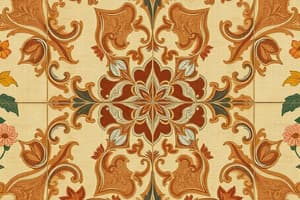Podcast
Questions and Answers
What is the main difference between the raw materials used for ceramic and porcelain tiles?
What is the main difference between the raw materials used for ceramic and porcelain tiles?
- Ceramic tiles use a mixture of clays, sand, and other natural materials, while porcelain tiles are made from finer, denser clay and often include feldspar, quartz, and kaolin. (correct)
- Ceramic tiles use a mixture of metals, while porcelain tiles use only clay.
- Ceramic tiles use a mixture of synthetic materials, while porcelain tiles use only natural materials.
- Ceramic tiles use a mixture of recycled materials, while porcelain tiles use only virgin materials.
What is the purpose of the drying step in the tile manufacturing process?
What is the purpose of the drying step in the tile manufacturing process?
- To add a protective layer to the tiles, making them resistant to stains and water.
- To add color and texture to the tiles.
- To remove excess moisture from the formed tiles, preventing cracking during the firing process. (correct)
- To increase the density and hardness of the tiles.
What is the main purpose of the glazing step in tile manufacturing?
What is the main purpose of the glazing step in tile manufacturing?
- To change the shape and size of the tiles.
- To increase the firing temperature of the tiles.
- To add color, texture, and a protective layer to the tiles. (correct)
- To remove any impurities from the raw materials.
What is the key difference in the firing temperatures used for ceramic and porcelain tiles?
What is the key difference in the firing temperatures used for ceramic and porcelain tiles?
Which of the following is not a common method used for forming tiles during the manufacturing process?
Which of the following is not a common method used for forming tiles during the manufacturing process?
What is the main difference between porcelain tiles and ceramic tiles?
What is the main difference between porcelain tiles and ceramic tiles?
What is the typical firing temperature range for porcelain tiles?
What is the typical firing temperature range for porcelain tiles?
What is the water absorption rate for porcelain tiles?
What is the water absorption rate for porcelain tiles?
Which type of tile is generally preferred for high-traffic areas or extreme weather conditions?
Which type of tile is generally preferred for high-traffic areas or extreme weather conditions?
What is one of the additional processes that tiles may undergo after firing?
What is one of the additional processes that tiles may undergo after firing?
Flashcards are hidden until you start studying




